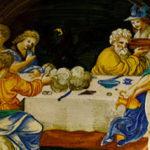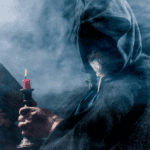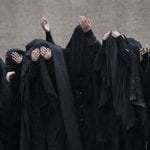 Weird Stuff
Weird Stuff  Weird Stuff
Weird Stuff  Mysteries
Mysteries 10 Tragic Disappearances and Deaths in Joshua Tree National Park
 History
History 10 Ways Childhood Really Sucked in the Old West
 Music
Music 10 Name Origins of Famous Bands from the 1990s
 Religion
Religion 10 Biggest Turnarounds by the Catholic Church
 Weird Stuff
Weird Stuff 10 Unbelievable Times Laws Had Unintended Consequences
 Humans
Humans Ten Historic Women Who Deserve Way More Credit Than They Got
 Movies and TV
Movies and TV 10 Films That Spawned Major Lawsuits
 History
History Ten Times Towns Were Wiped Off the Face of the Earth
 Creepy
Creepy 10 of the Most Disturbingly Haunted Public Houses in the UK
 Weird Stuff
Weird Stuff 10 Niche Subcultures That Are More Popular Than You Might Think
 Mysteries
Mysteries 10 Tragic Disappearances and Deaths in Joshua Tree National Park
 History
History 10 Ways Childhood Really Sucked in the Old West
Who's Behind Listverse?

Jamie Frater
Head Editor
Jamie founded Listverse due to an insatiable desire to share fascinating, obscure, and bizarre facts. He has been a guest speaker on numerous national radio and television stations and is a five time published author.
More About Us Music
Music 10 Name Origins of Famous Bands from the 1990s
 Religion
Religion 10 Biggest Turnarounds by the Catholic Church
 Weird Stuff
Weird Stuff 10 Unbelievable Times Laws Had Unintended Consequences
 Humans
Humans Ten Historic Women Who Deserve Way More Credit Than They Got
 Movies and TV
Movies and TV 10 Films That Spawned Major Lawsuits
 History
History Ten Times Towns Were Wiped Off the Face of the Earth
 Creepy
Creepy 10 of the Most Disturbingly Haunted Public Houses in the UK
10 Cults And Religions Of The Criminal Underworld
Gang initiations and rituals often mimic religious rites, and some say that gang activity fills a spiritual void in the lives of many of society’s marginalized. Some criminals adopt alternative religious beliefs to justify their activities and provide a sense of solace.
10 Santa Muerte
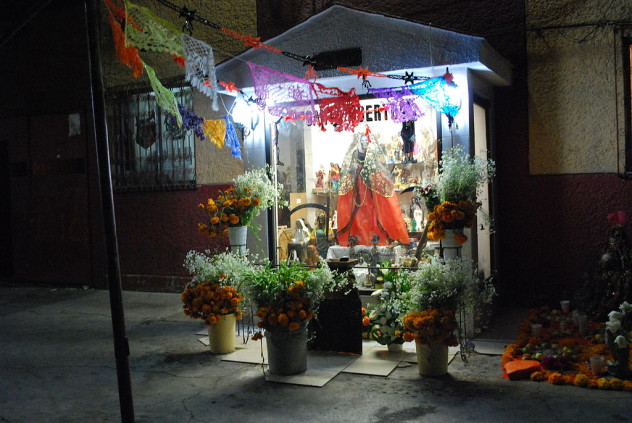
The cult of Santa Muerte, or Holy Death, can be traced to Mictlantecuhtli, Aztec lord of the underworld, and Christian personifications of death. In her modern incarnation, she appears as a skeletal figure in a wedding dress, carrying a scythe, and often adorned with fabulous jewelry and ornaments. Some claim that they can remember household shrines to the goddess over half a century ago, but her cult began to truly grow in the 1990s following the waning influence of the liberation theology of left-wing activist priests. Following the increasing conservatism of the mainstream Catholic church, many of the poor began to turn to Santa Muerte as a transgressive alternative faith.
She is said to be a protector of both criminals and the marginalized in society: the poor, prostitutes, and drug addicts. She has many names, including the Skinny Lady, the Bony Lady, the White Girl, the White Sister, the Pretty Girl, the Powerful Lady, and the Godmother. She is paid homage to with gifts of tequila and water in exchange for boons and protection. She is described as a “bad bitch,” a doting grandmother figure, and a representation of the holy power of death.
Santa Muerte is a popular focus of worship in Mexico’s prison culture, where she is believed to protect against nosy wardens and the aggression of other inmates. Her cult has also infiltrated many of Mexico’s cartels. She has an appeal to the criminal world because while holy death eventually comes for us all, she does so without judgment.
As she is an unrecognized saint, devotees can ask things of her they would not dare ask of an official Catholic saint figure. The majority of the 5–10 million Santa Muerte devotees in Mexico and the United States still consider themselves Catholics. The official stance of the Church is that since Christ is said to have defeated Death, the worship of Santa Muerte is tantamount to the worship of Christ’s enemy, Satan. Some priests even blame her for a boom in demon possession cases, which have allegedly left Mexico’s officially sanctioned exorcists horribly overworked.
9 Jesus Malverde
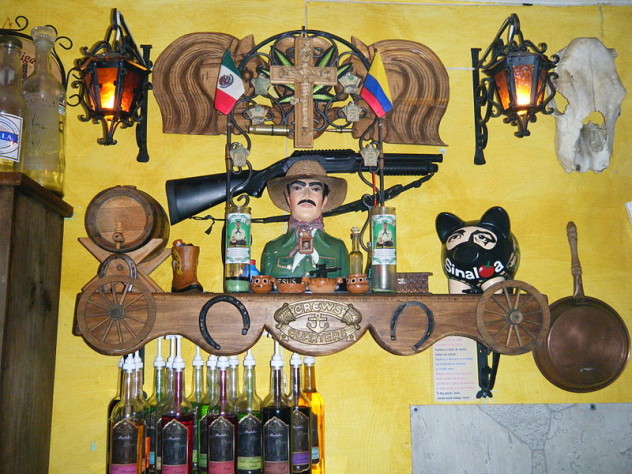
Often compared to Robin Hood, Jesus Malverde was an early 20th-century Mexican bandit who robbed from the rich, gave to the poor, and was eventually hanged by the government in 1909 for his trouble. Soon, people in the northwestern region of Mexico began to revere him as a saint, referring to him as “The Angel of the Poor” and “The Generous Bandit,” though he remains unrecognized by the Catholic Church. It’s rumored that he performed miracles after his death, like helping find a lost cow for one follower and a mule laden with silver and gold for another. The faithful began to stream to his shrine in Culiacan, Sinaloa, to ask for boons and thank him for what he had already granted them. Offerings to the saint may include photographs, photocopies of recently acquired passports, corncobs, artificial limbs, jars of shrimp in formaldehyde, and even guns—all symbols of some material success attributed to Jesus Malverde.
Since Mexican drug smuggling began in Sinaloa and many traffickers come from the same poor and highland background as most of Malverde’s believers, it is no surprise many in Mexico’s narcoculture venerate him as the “Narco Saint.” Since then, his mustachioed, slightly glum visage has been honored in shrines across the country. He is particularly popular among mid-level members of drug cartels because he is believed to give protection against the violence and uncertainty of the drug wars. He is also popular among the marginalized—drug users, prostitutes, the handicapped, pickpockets, thugs, and the destitute.
In recent years, the cult has become more mainstream with families maintaining shrines in their houses and an annual festival where the face of Jesus Malverde is washed in holy water, caressed, given cigarettes, and even bathed in top shelf whiskey. During the festival, bands play narcocorridos, songs glorifying the drug trade, and there are donations of food, toys, and household items to the community.
8 The Kingston Group
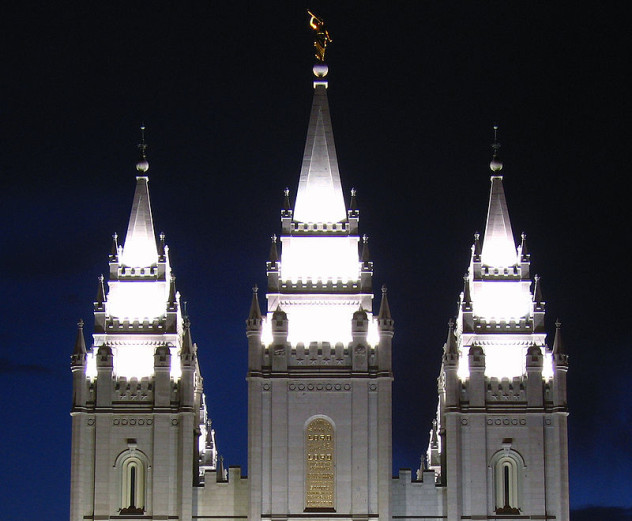
The Kingston Group, known as the Order internally and the Davis County Cooperative Society officially, is a powerful clan of Mormon fundamentalists said to control the largest criminal organization in Utah. The Kingston Group utilizes its younger members as virtual slave labor while maintaining a public front of a cooperative society and business enterprise owning almost 100 businesses in Salt Lake City as well as a casino, cattle ranches, and factories across the country. The members blend into the wider community, maintaining a front of politeness and wearing nondescript clothing, as a cover for a massive crime ring and cult practicing polygamy and child abuse. The Kingston Group is a bizarre offshoot of Mormon fundamentalism first founded by Elden Kingston during the Great Depression after he supposedly received a revelation from an angel to form a “united order.”
He believed the Church had lost its legitimacy when it gave up polygamy in 1890 and that he was descended directly from Jesus Christ. Today, his descendants believe in keeping their bloodline pure (which means incest and high rates of genetic deformity) so they must avoid hospitals and birth records for fear of scrutiny. Elden Kingston also preached of a hierarchy system called the Law of Satisfaction, ranking everyone in the community from the leaders down to the wives and children. Husbands ranked higher than wives, first wives ranked higher than second wives, and so on. Children and teenage wives are used as slave labor in stores and coal mines and paid in “scrip,” currency used only among the Order.
Elden was replaced after he died in 1948 by his brother J.O., who taught women of the clan to defraud the government through fraudulent welfare claims, a practice known as “bleeding the beast,” and began purchasing slot machines from the mob.
They have extreme natalist views that maintain an extremely high birth rate, which results in poverty and hunger among members of the clan. An ex-member kicked out for being gay alleged that his father told his mother, “You know, it’s been two years since you had a kid. With cows we slaughter them if they don’t have a calf every two years.” The group is said to maintain its criminal empire with a good legal understanding of how to manipulate local politicians as well as an isolationist attitude and avoidance of public hospitals and the police. One former member put it this way: “Money, sex, and power. They’ll do what they need to do to defend what’s theirs.”
7 Master Handan
During the Taiwanese lantern festival, people in Taitung County throw firecrackers at a shirtless man playing the role of Master Handan. Some cultural historians believe Master Handan was a god of wealth who could withstand the cold. Throwing firecrackers at men representing the deity, dressed in masks and shorts with only a banyan branch each for protection, is a way of honoring the god and ensuring wealth and prosperity. How the ritual began is unknown, but it was first recorded during the Japanese Imperial Period. Some claim honoring Handan with fireworks was rewarded by the god, who cleared the city of infectious diseases. Scientists believe the heat and thick smoke during the bombardment may have helped reduce the transmission rate of bacterial infection. Others believe Handan was actually the god of gangsters and hooligans.
Beginning in the 1970s, crime syndicates in Taitung adopted the ritual of “bombarding Master Handan” as a way of determining which rival faction’s leader would become the new boss. Whoever could endure the bombardment for the longest had the cojones to lead the gangsters. The ritual was banned in 1984, and police raids attempted to put a stop to it. But since 1989, the ritual has been officially celebrated as cultural heritage and a tourist attraction for the city. However, veneration of Master Handan is still prevalent in the Taitung underworld, and during the lantern festival, gangsters still mount palanquins exhorting local residents to shoot them with fireworks. In 2006, filmmaker Ho Chao-ti released The Gangster’s God, which explored the cathartic and redemptive aspects of the ritual for its participants and their community.
6 Knights Templar Cartel
An offshoot of the defunct La Familia Michoacana drug cartel, the Knights Templar Cartel, Guard of Michoacan, or Los Caballeros Templarios Guardia Michoacana, was formed following the death of La Familia leader Nazario Moreno Gonzalez. La Familia had been known as a “narco-Evangelist” cartel whose leader wrote a book of religious ramblings he forced his troops to read. The leaders of the new cartel, led by Servando Gomez Martinez, or “La Tuta,” decided religious discipline was needed to keep cartel members in line. He modeled their organization after the medieval crusaders of Jerusalem. They announced their presence by raising banners throughout Michoacan reading, “Our commitment is to safeguard order, avoid robberies, kidnapping, extortion, and to shield the state from rival organizations.” But soon they were hanging corpses, claiming them to belong to criminals and sinners, and wiping out their old allies still loyal to La Familia.
The Knights Templar believed in a code of honor, which they detailed in a pamphlet bearing images of knights on horseback bearing lances and crosses. They claimed to promote “gentleman-like behavior,” respect for women, and opposition to poverty, tyranny, and injustice. Evidence seized by Mexican Federal Police indicated the use of hooded robes, crosses, and metal helmets in rituals. Many who join the cartel are drug addicts who are put through a religious rehabilitation program by the group, then forbidden to take drugs.
Some claim new initiates of the group perform blood rites and even consume children’s hearts. After the capture of La Tuta in early 2015, the cartel’s cult appears to have collapsed, but some fear the collapse of the Templar command structure will lead to more violence and another cartel sweeping in to fill the power void.
5 Guan Yu
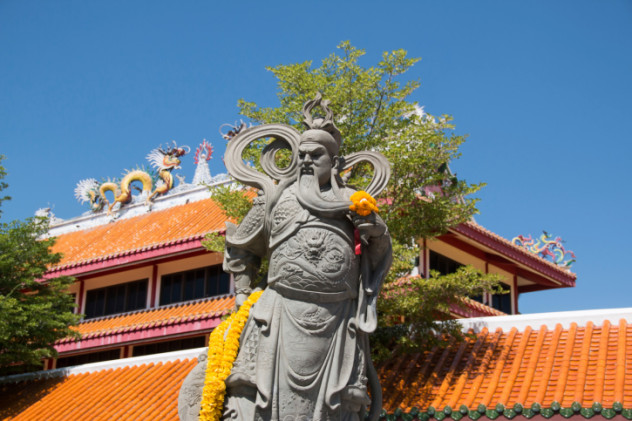
Guan Yu, sometimes known as Guan Gong (Lord Guan), was a general who served the warlord Liu Bei in the late Eastern Han Dynasty during the third century BC. He helped cause the civil war to bring down the Han and the rise of Shu Han, of which Liu Bei became the first emperor. There was a legend telling of Guan Yu, Liu Bei, and Zheng Fei, another general, swearing a blood oath in a peach garden to become brothers. Over the centuries, Guan Yu has become an icon of loyalty and righteousness, eventually recognized as a god of war and wealth, widely worshiped in mainland China, Hong Kong, Taiwan, Singapore, and Chinatowns around the world by businessmen, shop owners, and kung fu practitioners. He appears in shrines as a mighty warrior with a stern red face, holding a halberd.
Interestingly, he is the patron saint of both policemen and criminal triads, as both groups have a keen sense of brotherhood and a code of honor. Statues of Guan Yu in police stations hold a halberd in the right hand, while those in triad shrines hold a halberd in the left hand and are usually more stern and threatening in their appearance. For triads, his loyalty reflects the loyalty of secret society blood oaths. Some say the legend of the blood oath in the peach garden represents the “family” between police, business, triads, and kung fu schools. In the early years of the triads, figures such as Guan Yu and Liu Bei were important representations of loyalty, but less important than the influence of the White Lotus religion. But since then, his influence has grown.
In late 2014, Hong Kong pro-democracy protesters erected a statue of Lord Guan in the middle of Mong Kok to serve as a strategic deterrent against intervention by either police or the triads. This worked for a few weeks, until police were clearing the area and accidentally knocked the statue down, breaking off one of its hands. Subsequent bad luck for the cops (including one official accidentally wearing a hat bearing the old seal of Hong Kong’s colonial police, with British crown, to a news conference) was blamed by some on the god’s righteous indignation.
4 Nigerian Confraternities
When the first Nigerian confraternity, the Pyrates Confraternity, was founded in the early 1950s, it was intended as a student club serving as a social liberating influence in fusty University College, Ibadan, Nigeria’s oldest tertiary education facility. In the 1960s and ’70s, confraternities became radicalized by anti-colonialism, Marxism, and pan-Africanism. They became more ritualized in their uniforms and initiation ceremonies. Civil War, reaction to Pentecostalism and radical Islam on campuses, and the destructive growth of the oil industry helped to change the nature of the confraternities into militarized criminal cults. Violence on campus increased, and the confraternities began to incorporate traditional religious objects—juju—into their initiations.
Notable confraternities included the Klansmen Konfraternity, the Supreme Vikings Confraternity, and the Black Axe Confraternity, all of which were involved in violence both on and off campus, as well as criminal street gangs and corrupt politicians. In the 1990s, they were deeply involved in the drug and weapons markets and the illegal siphoning of petroleum, known as bunkering. Cultists have been involved in racketeering, armed robbery, assassination, prostitution, political intimidation, bribery, human trafficking, and kidnapping.
Confraternities remain a serious problem in Nigeria today. In May 2015, over 30 people were killed in confraternity wars in Benin City, Edo State. Police shocked the community by alleging that 14 junior secondary school students ranging in age from 12 to 15 were involved in the attacks. A month earlier, a number of alleged confraternity leaders were arrested, including four government functionaries.
Confraternities have also spread abroad. In 2007, Italian police arrested members of the Eyre Confraternity to prevent looming violence. This cult, which has branches throughout Europe including the UK, is known for its uniform of blue hats, clothing, and shoes as well as a ritual in which cultists bleed into and later drink from a communal bowl.
3 Santos Malandros
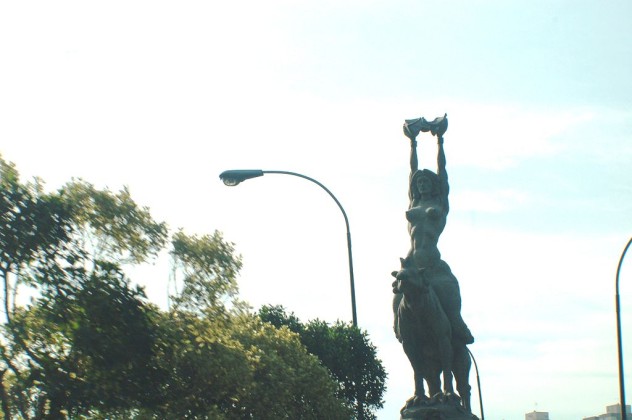
Maria Lionza is said to have been the daughter of a native chief who sent her into the wild. She would later become a folk hero in Venezuela. When Spiritism entered the region in the early 20th century, she came to be considered a guardian spirit around the holy mountain of Sorta in Yaracuy State. Her legend combined with Spiritism as well as Catholic, African, and indigenous beliefs to form a new religion based around the consultation of spirits. These spirits are arranged into courts: the Celestial Court, the court of the Africans (which includes Santeria Orisha figures), the Liberator’s Court (which includes the revolutionary Simon Bolivar), the court of the Indians, and even the court of the Vikings.
One of these spirit courts is the court of the criminals, also known as Santos Malandros, or the Holy Thugs. It is headed by Ishmael Sanchez, a petty criminal who was gunned down by police in the 1970s. The Santos Malandros gained popularity following three days of riots in Caracas in 1989 and were absorbed into the syncretic Maria Lionza faith. The Holy Thugs are depicted as garish figurines with baseball caps on backward, cigarettes dangling from their mouths, and guns in their belts. Tobacco is considered sacred to the court, and all worshipers, even children, will smoke cigars during worship. Back in Caracas, worshipers offer liquor and cigarettes at Ishmael Sanchez’s grave site. The criminal’s court attracts criminal worshipers who want help with their illegal activities—but also those who want to protect themselves from the depredations of crime. Like Jesus Malverde, Ishmael Sanchez was allegedly a figure who robbed to give to the poor and was gunned down by a crooked cop.
2 Palo Mayombe
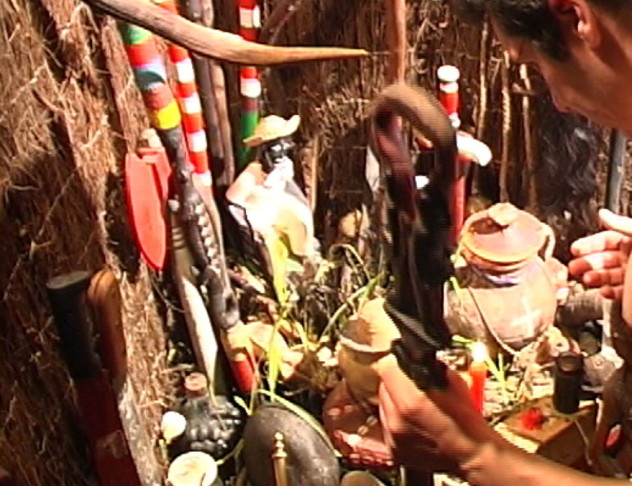
Slaves shipped from the Congo to Cuba by the colonial Spanish brought with them their religious beliefs, which in the New World included Santeria and other African religious traditions. One of these traditions was Palo Mayombe. This faith is often maligned in the media, erroneously called Satanism or “Santeria’s evil twin.” In reality, is a syncretic religion that combines traditional Congolese beliefs with Catholicism and some Yoruba practices. While it shares some features with Santeria, which primarily derives from Lukumi/Yoruba beliefs of present-day Nigeria and Benin, Palo ultimately differs with its Congolese origin. Although many Palo practitioners have Santeria training, many Santeria followers fear Palo Mayombe as witchcraft. Palo rituals involve a nganga, a ceremonial cauldron containing earth, sticks, and animal or human remains. Animals are sacrificed over the nganga in order to feed the spirits within. The nganga represents the universe; through sacrifice, a Palo priest, called a Palero or Palera, can instruct the spirits to perform works of magic, heal, curse, or make pacts. Animal sacrifice and the use of human bones has lead to Palo Mayombe practitioners running afoul of the law on charges of animal cruelty and grave robbing.
Palo has thousands of peaceful and law-abiding practitioners, but it has also been appropriated by the criminal element, who seek to use its powers for protection against rivals and the police. One technique is inscribing signatures onto parchment or a brown paper bag, which is then placed into a nganga, over which two black pigeons, a red rooster, and two white quails are sacrificed. The blood-soaked paper is then folded and placed with a hummingbird’s heart inside a small leather bag, becoming an amulet meant to render the wearer invisible to the police.
While the media often conflates and misinterprets Afro-Caribbean religious traditions, there are still individual practitioners who use the faith in order to justify crimes. Perhaps the most notorious example of Palo Mayombe gone wrong was in the case of Adolfo de Jesus Constanzo, a Palero who sold his magical talents to Mexico’s cartels and elite in the 1980s. Adolfo de Jesus Constanzo diverged from standard practice by adopting human sacrifice. In 1986, the mutilated body of a baby boy was found in Connecticut with ritual items—coins, fruit, burlap—linking it to a possible Palo Mayombe ritual.
Palo Mayombe lacks a centralized doctrine or hierarchy, meaning its practices can be adopted by individuals with criminal intentions relatively easily. In 2010, Los Angeles used car dealer Ruben Hernandez attempted to use Palo Mayombe rituals against prosecutors and investigators when he was accused of fraud. Hernandez claimed the ritual was not a curse but a form of “spiritual acupuncture” designed to make them believe he was a good man. A year earlier, an illegal grenade manufacturer in Puerto Rico was caught in a sting by undercover agents posing as drug cartel members. In his home, along with signs of syncretic Santa Muerte worship, they found evidence of Palo Mayombe rituals involving (legally sourced) human bones and the police badge of a former Rio Grande City officer.
1 Prison Pentecostalism

The prisons of Rio de Janeiro are controlled by violent gangs, but they have made space for the rise of Pentecostal churches in their midst. These prison churches derive their organization structure from Pentecostal churches outside prison, but also from the gangs inside the prisons. The first prison churches were called Comando de Cristo (Christ’s Command), based on the name of Rio’s largest criminal gang, Comando Vermelho (Red Command). The small groups began to grow and claim parts of the prison as their own territory. Pentecostal inmates lived together in the celas dos crentes (Believer’s Cells). Pentecostal teachings appeal to many inmates due to the emphasis on redemption, and the greater activism by Pentecostals among Brazil’s poorest populations, compared to the Catholic majority. The Pentecostalism within the prison bears a resemblance to gang life, with an adherence to strong charismatic leaders and membership in the church offering protection from threats.
These churches usually make up around 10 percent of the prison population, much smaller than the secular gangs. But the gangs respect the churches, and in turn the churches do not interfere with the gangs. Gang members are allowed to leave their gangs and join the church community, but only if their conversion is genuine. Church members are forbidden to take drugs, so if someone converts and is found to have taken them, they will be expelled from the church and suffer harsh punishment for their disloyalty from their former gang. But the balance between church and gang maintains an order within the prisons to a much greater extent than the facade of control exercised by the wardens. Some former prisoners converted to the faith return after their release to work with inmates. One inmate, Daniel Ruffinnati, credits his conversion with curing his schizophrenia and now works with a social outreach program.
Not all interactions between burgeoning Pentecostalism and the world of crime is so rosy, however. Informal, unregulated, and for-profit compulsory rehabilitation centers run by Pentecostal and Charismatic churches in Guatemala are holding drug users against their will with government approval. Filthy abandoned buildings have been turned into fortresses to house the users who are forced to maintain them while pastors make money from their families for rehabilitation. Drug users are delivered to the centers by the police or captured by collection gangs by force. With little government oversight, many of these centers are rife with physical, psychological, and sexual abuse.
David Tormsen hopes he performs posthumous miracles, but would rather not run afoul of the Mexican authorities to make it happen.

